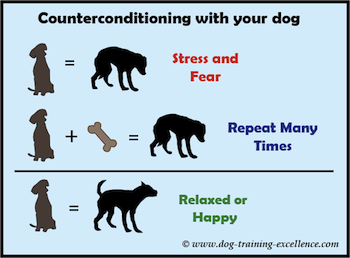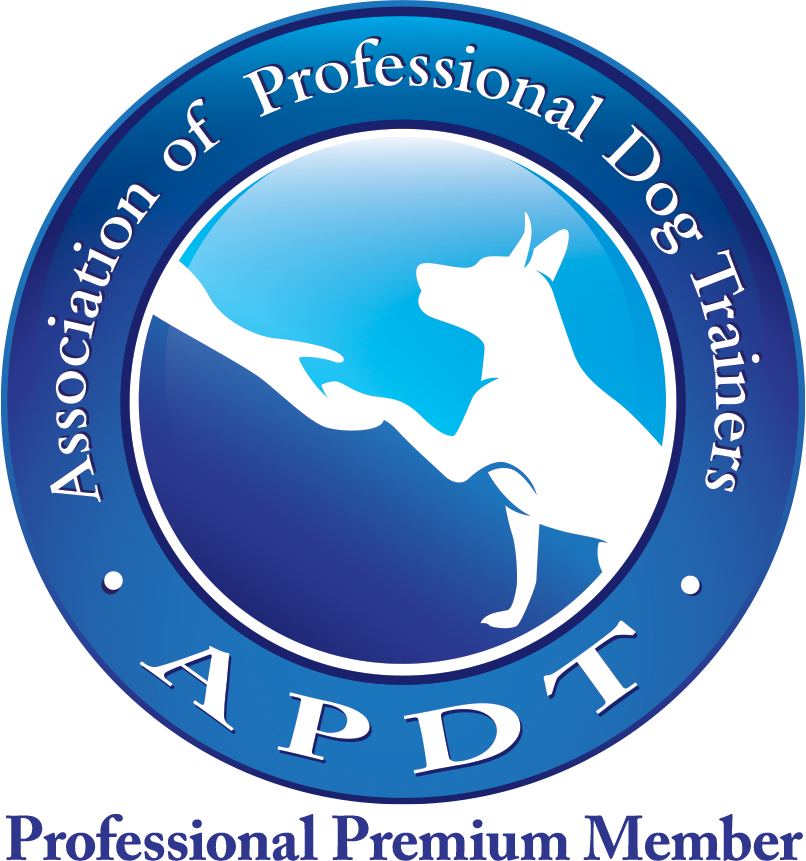I try to write my posts as unbiased as possible and recommend the products I consider to be useful and the best. I use affiliate links, this means that–at no extra cost to you–I can make a commission on a purchase you make after clicking on them. As an Amazon Associate I earn from qualifying purchases.
What is counterconditioning
and how to use it?
Counterconditioning might seem like a big word, but don't worry. It's actually very simple. You might already have been using classical conditioning to train your pooch the meaning of a marker word. Counter conditioning is similar.
This time your dog already has a conditioned response to something, like another dog or person (he barks, snarls and shows fear). With this technique we will change that conditioned response into a new one (happy and relaxed).
Counter conditioning, sometimes also referred to as reciprocal inhibition, is a technique used in dog behavior modification. It is used to change the way a dog "feels" about something.
For example, we can use counter conditioning for fearful dogs. If a pooch is scared of the mail man, we will use this technique to make him feel happy about him instead! This method works best when used together with systematic desensitization as explained below.
How to use counterconditioning?
We will give your dog something he loves! (hot dog pieces, cheese, whatever he goes nuts about) every time the scary object appears in sight.
That's it!
It is very important to give the reward as soon as your dog sees the scary thing. Then all you have to do is repeat…repeat…and repeat. You know when you are being successful when your dog starts showing signs of happy excitement at the sight of what previously was scary.
To help you see when your dog is happy or fearful read about dog body language here!
Lets learn counterconditioning with an example.
In this case your dog is afraid of your hairdryer but you can use a similar approach to any kind of fear.
Step one: Take the hair dryer out and as soon as your dog sees it give him a piece of hot dog!
Step two: Repeat step one until your furry friend gets really happy when he sees the hair dryer (because he knows he will get a piece of hot dog).
Step three: have someone turn the hair dryer on in a different room from where you and your dog are. As soon as you both hear the hair dryer go on…you guessed it…give him a piece of hot dog!
Step four: repeat step three until you dog gets really happy at the sound of the hair dryer.
Step five: Now you will turn the hair dryer on while in the same room with your hound. But keep it under a towel to muffle the sound a little bit. Give your pooch a piece of food every time you turn it on, in fact keep giving him pieces of food (one at a time) while the hair dryer is on. When you turn it off the hot dogs go away too!
Step six: do this until your furry friend is wagging his tail happily when the hair dryer is on.
Step seven: Now repeat steps 5-6 but with the hair dryer in plain view…and repeat this from the lower setting to the higher speed.
Step eight: finally start giving your pet food rewards less and less often. For example, before you were giving him hot dogs continuously. Now do it every 2 sec…every 4 sec…and so on until you can get away with giving him only one piece of food for the whole time it takes you to dry your hair! (Ideally you will give him the piece of food at the end of your hair drying not at the beginning).
Counterconditioning and desensitization together!
If you noticed in the example above I didn't tell you to turn the hair dryer on in the dogs face and give him treats. Why? because if you did this your hound would probably be very scared, try to run away, hide and would most definitely not accept anything to eat.
Would you eat anything if I put you face to face with the most scary thing? probably not.
That is why in the example above we introduce the hair dryer silent first, then with the sound from a different room…and so on. This is called Systematic Desensitization and it is used also to get rid of fears in humans as well as pets. The idea is to get closer and closer to the scary object very slowly…so slowly that each step of the way doesn't cause the animal any fear reaction.
For example, if your dog is afraid of other dogs, you would want to start the session with another dog far away…how far away? well, it has to be far away enough that it doesn't trigger a fear reaction in your pooch (no barking, tensing up, etc) and your dog has to be able to see the other dog.
Then you would pair it with a treat (counterconditioning). When your dog is getting excited at the sight of the other dog in the distance (because it predicts that food is coming!) it's time to move a little closer…and so on.
Key points to remember
- The key to counterconditioning is timing! Just like any conditioning exercise, you need to give your pet the reward as soon as the scary object is seen _by your dog. If you give the reward before or too late after…it might not work.
- The key to systematic desensitization is to go very slowly! If at any point your dog shows a fear reaction it means you are going too fast! Here you have to be very creative to figure out how to make smaller steps. Distance is one way, muffling sounds is another way, approaching the scary object at an angle instead of head first could be another way.
- Never punish your fearful dog. This will only make his fear worse!
- Seeking the help of a professional dog trainer is a good idea. Specially if you think your dog might harm you, another person or dog or himself.
Home > Dog Training Methods > Counterconditioning





New! Comments
Questions? Anecdotes? Tips? Leave me a comment in the box below.